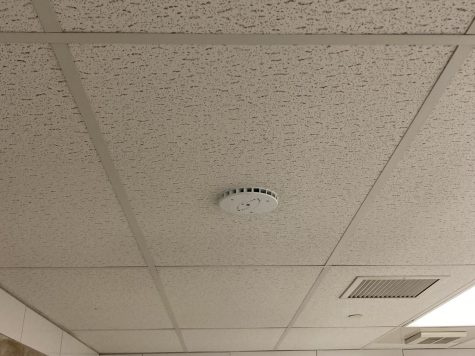ICCSD installs vape sensors in West High bathrooms
Over the summer, the Iowa City Community School District implemented vape sensors across all district high schools.
On Aug. 23, the hallways of West High were once again overflowing with students. Shouts of reunion filled the halls. All the while, an underlying feeling of unease crept into the back of students’ minds. They had heard the rumors. Vape sensors were now in the bathrooms.
At the end of last year, the district decided to install vape sensors in all the bathrooms at Liberty, Tate, City and West High Schools. Their budget for this project was $350,000 and these sensors were set up in every restroom at West High over the summer. Each sensor is accompanied by a security camera placed outside every restroom so the district can monitor who enters and exits each restroom. If a sensor is tripped, an email is sent to the administration with a code specifying which bathroom the sensor was activated in. They can then compare the camera footage with the information from the sensor and evaluate the next steps.
A common concern among students is that, with this system, students will be falsely accused of vaping in bathrooms. West High Principal Mitch Gross countered this rumor.

“Theoretically, it could happen,” Gross said. “But it hasn’t happened yet. Ninety percent of the students who tripped the sensor have admitted to what they were accused of. If you walk in and see somebody vaping, walk right out. You don’t want to be guilty by association.”
On the first day of school, many teachers and students were concerned with the number of times the vaping sensors were set off. That number is misleading, though, since the sensors also gauge decibel levels. They are programmed to sense a general disruption in the environment and since the sensors were calibrated to a completely empty school, every little sound set the sensors off.
“Anytime someone slammed a stall door, it tripped because [the school] had been quiet for some time,” said Gross. “We ended up having to call the district and shut off the noise piece because anytime a toilet flushed, it was tripped.”
Since then, the sensors have become a popular topic of discussion among students and staff. John Cooper, an English teacher at West High, shares his perspective on the conversation around the vape sensors.
“The big discussion here I think needs to shift from the sensors — whether or not we can catch you like a game of cops and robbers — to education, to the level of toxicity in those things. If anything, it sounds like the information we’re getting indicates an epidemic of vaping,” Cooper said.
According to Cooper, teachers have been very supportive of the sensors since they first heard about them last year.
“The first time that I had to write up a kid and the kid got suspended for a couple of days for vaping in my class was in 2017. I’m aware of kids who were vaping in the school as far back as 2015, 2014,” Cooper said.
2015 was the year a small and discreet method of vaping hit the market. JUULs were introduced and quickly took off in the teenage population, drawing adolescents in with a wide variety of flavors. High school e-cigarette use increased by 135% from 2017 to 2019, according to the National Youth Tobacco Survey (NYTS). Julian Gentiluomo ’23, a student who doesn’t vape, elaborates on how popular these e-cigarette devices are at West High.
“I think it’s really hard to not know people at the school [who do it]. You’d have to be in a very tight-knit crowd and not expand outwards do not know anyone that vapes here,” Gentiluomo said.
An anonymous student at West High opened up about their personal experience with vaping, which started during their sophomore year.
“When I was with my friends, we were all like, ‘Yo, we should get a vape like, that’s so cool.’ So we did and I kept it. I never actually hit it, though. But as time went on, I got depressed. I thought, ‘Let me try this thing out.’ And so that I did. I know if I really wanted to stop I could have stopped, but I didn’t (want to stop),” they said.
The anonymous source also indicated that they felt no addiction to nicotine, but they know people around them who are addicted. However, it’s uncommon to use nicotine regularly and not become addicted. Inhaling nicotine increases levels of the neurotransmitter dopamine in the brain, which reinforces the behavior of taking the drug. This could cause students to feel the need to vape in school bathrooms and risk being caught.
When a student gets caught vaping, there are certain consequences that are put in place. According to the district’s handbook on discipline, they try to avoid suspension by implementing other forms of discipline such as having students do research on the negative effects of vaping. The consequence for the first time a student is caught vaping is spending time in the student prevention access connection and engagement classroom (SPACE). It also involves contacting parents, along with confiscating any products and a bag search. The consequence of a second offense is a suspension in or out of school for up to three days. If a student is found with marijuana, they are faced with a 5-day suspension.
An important aspect of the punishment for vaping at school that many students don’t realize is that it falls under a violation of good conduct, according to the district’s handbook.
“If you’re a musician, an athlete or doing any other extracurriculars if you get caught vaping, you will lose a third of your season,” Gross said.
For students facing the threat of getting caught by the sensors, the most common opinion is that the sensors won’t work.
“People are going to go and get another vape. It’s not going to stop anyone,” our anonymous source said.
Gentiliuomo adds, “I think if [the school district] did, truly, truly want to actually prevent students and kids from vaping, a harsh punishment would not be the solution.”
Gross’s opinion about the punishments differs.
“If [the sensors] can be a deterrent, they can be effective from that standpoint.”
Vaping can also have an impact on people around you.
“Humanity as a whole is always going to struggle with addiction to nicotine,” Cooper said. “But it takes an individual caring about themselves and those who they love to make the change in their own life and not become subservient to a chemical.”
Your donation will support the student journalists of West High School. Your contribution will allow us to purchase Scholarship Yearbooks, newsroom equipment and cover our annual website hosting costs.

(she/her) Laney Prelle is a senior at West High and this is her fourth year on staff. She is the online profiles editor and her hobbies outside of writing...

(she/her) Audrey is a senior and has been on the West Side Story staff for 3 years. She is the Copy Editor for the WSS website this year. For fun, she...


